Today I'm going to share my system for recording my workouts using a workout tracker. (If you're just getting started working out, check out How to Start Working Out When You Don’t Know What You’re Doing and 3 Simple Ways to Make Exercise a Habit.)
In my opinion, tracking your workouts (whether it be with a workout journal, a fitness app, or something else) should accomplish three goals…
- Your workout tracker should be quick and easy, so that you can spend your time exercising. Your time should be spent doing the work, not recording it.
- Your workout tracker should be useful. Our modern world is overflowing with data and most of it is never acted upon. I prefer a system that records the essential information of what I have done (so I can see my progress), that reduces errors while I am working out (so that I can be more effective with my time), and that helps me make informed decisions about what to do during my next workout.
- Your workout tracker should be versatile. I don't want to have to find a new app or develop a new system every time I want to do a different style of workout. I should be able to adapt my current system to any style of training.
With those goals in mind, here's the workout journal tracking system that has worked best for me.
Hacking the Workout Journal
Naturally, I use the Clear Habit Journal. Obviously, any notebook will do, but I like this particular one because it is the perfect size and it has a firm cover that doesn't bend or tear with repeated use.
STEP 1: Write the date and your bodyweight (if you wish) at the top of the page.
I typically do this once I show up to the gym. It's part of the pre-game routine that I go through before working out. I put on my lifting shoes and knee sleeves, get out my lifting belt, write the date at the top of the page, and weigh myself.
STEP 2: Write your planned workout routine for the day in the following format:
[Exercise] – [Weight] – [Sets] x [Reps]
At this point, I write out what I expect to do for the day. In the beginning, you may need to think about this a bit or spend some time finding a program that you enjoy. After the first or second time, however, writing down your workout is a very quick task.
Currently, this process takes me less than 60 seconds because I usually measure backward and base the weights I lift today on what I did the week prior by simply adding 5 more pounds or an extra set. (This is another advantage of using the notebook. Your recent workouts are just one or two pages away, so you can pull information instantly.)
I prefer to write out every set I'll do, including warm-up sets, because it makes the process of working out even more mindless and automatic. Once I have a plan, I can just pick up the weights and go. In the rare case that I don't know exactly what weight I will hit (for example, if I'm maxing out on a particular day), then I'll just leave a few blank lines under that exercise so that I can write in the numbers as I do each set.

STEP 3: Record tally marks as you complete your work sets.
When you're in the middle of a workout, it can be easy to forget what set you just completed. This is especially true when the weight gets heavy and you're too busy huffing and puffing to remember if you just finished set 4 or set 5.
To avoid this occasional mental lapse, I like to use tally marks to note when I finish each set. One quick mark and I always know where I'm at in the workout.
For me, the lifting sequence usually goes like this:
- Do the lift.
- Make a tally mark.
- Start the stopwatch to record my rest interval. (I use the stopwatch application on my phone to track rest intervals, but a regular stopwatch or a glance at the clock on the wall works just fine as well.)
- If necessary, change the weight for the next set.
- Repeat.
STEP 4: Vary this basic structure as needed for the training session.
The beauty of this system is that it's incredibly versatile while still being clean and simple for any given workout. (Most apps and pieces of software meanwhile are either simple but limited, or versatile but bloated with features.)
For example, I rarely add rest intervals to my strength training sessions because they are almost always between 3 to 5 minutes. When I sprint, however, I prefer to have the rest interval listed because it is more integral to the workout. No problem. I just add it to the line under the exercise.
Here's what a typical sprint workout looks like for me…

And that's it.
Bodyweight workouts, strength training workouts, sprint workouts—this workout journal works for all of them. It's simple, it's adjustable, and it works. 1
In the examples above, I only listed one exercise per workout so that I could lay out the format clearly. Obviously, when you are doing multiple exercises per workout, you simply follow the same structure and add each additional exercises under the previous one.